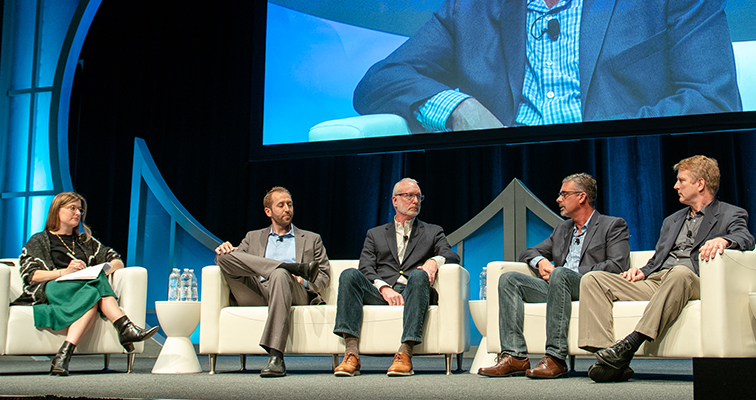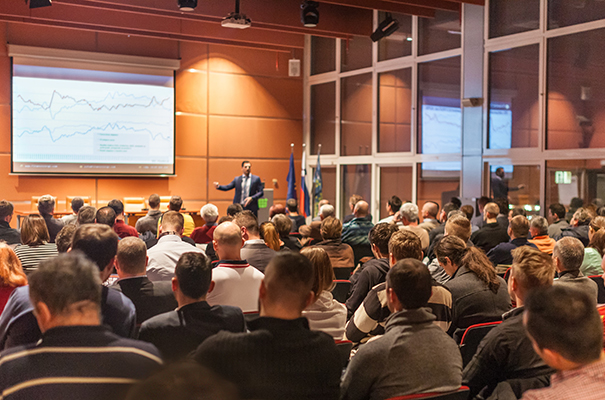Is Higher Education the AV Industry’s Oldest Sleeping Giant?
By estimates, the market for audiovisual solutions and services in higher education is robust and growing — poised to expand faster than markets such as corporate AV, retail, and entertainment. It’s also one of the industry’s most proven segments. In the 1940s, when AVIXA was first founded, it was established in large part by companies that wanted to sell more new technology into schools.
But doing business in higher education can be tricky. It’s a fragmented market — needs differ greatly from school to school, or department to department. It’s often characterized by traditional pedagogies that don’t always reflect technology-based learning. And, frankly, it operates on a pretty set schedule.
“We’re beholden to the academic calendar,” said Mark Russell, Manager of Learning Spaces and Technology Services at Indiana University (IU). In fact, Russell explained, one reason that IU services classroom AV itself, rather than contract the responsibility to an AV provider, is that “lost instruction time is something we won’t stomach.”
 Learning panel at 2019 AV Executive Conference
Learning panel at 2019 AV Executive Conference
At universities, AV integrators may deal with many internal colleges, each with different leadership. “And a lot of times they don’t talk to each other very much,” said Jeff Bethke, Vice President of Engineering at Level 3 Audiovisual. “We’ll be putting in a box-sale Extron system that a three-person department is going to deploy and then across the street we’ll get a spec that’s all Crestron.”
Bethke and Russell spoke recently at AVIXA’s 2019 AV Executive Conference in New Orleans, on a panel sponsored by Bose Professional. The panel agreed: The higher education market is evolving to be more open to new AV technologies that support contemporary learning styles. In addition, schools are adopting more AV systems — often in conjunction with capital-intensive projects and new construction — to stay competitive and meet people’s expectations.
And other trends in higher ed bode well for the AV industry moving forward. “Just a few years ago, architects would come to me and say, ‘We’re doing this capital project and I’ve got $685,000 for the AV, what’s it really going to cost?’” said Russell. “Now they’re bringing us to the table during programming and saying ‘Hey, we’re going to embark on this capital project, these are the things we hope to accomplish, how much money do you need in your AV budget?’ That’s a very different conversation.”
Growing Investment in Higher Ed AV
According to AVIXA’s 2019 Industry Outlook and Trends Analysis (IOTA), the market for pro AV products and services in education (including K-12/primary) is growing faster than the overall AV market. Researchers expect revenues to reach nearly $20 billion worldwide this year and grow 6 percent annually through 2024.
According to AVIXA’s latest Market Opportunity Analysis Report (MOAR) focused on education, 36 percent of decision-makers in education indicated that budgets for classroom improvements were poised to increase significantly. When it comes to implementing AV in classrooms, 82 percent said they believe AV can help teachers teach; 73 percent said it increases student engagement; and 61 percent said AV in learning spaces boosts collaboration among students.
“Learning spaces are no longer rooms where people go to sit and you can just place a camera and locate microphones to pick up those seats,” said Jon Schau, Lead Engineer for Emerging Technology at Bose Professional, during the AVEC panel. “People are dynamic; they’re moving around. You’ve already seen trends in technology — wider field-of-view cameras and microphone arrays — that let you deal with that kind of space.”
At the end of the day, decision-makers and technology managers in higher education say they look to the AV industry to understand their needs and produce designs that meet them.
“The value proposition for integrators is that this stuff is all complicated,” said Bethke. “[Schools] want classrooms and multipurpose rooms with modular furniture and TVs on the walls and projectors. What’s the use case? Routinely we’re seeing floorplans and we know it’s never the only version of that room. Eight or nine other seating plans come at you and it’s a totally different design. That’s where our value comes in. Knowing the technology and what can be done with programming and automation to help support those different applications and make sure they’re easy to use.”
Five Reasons Higher Ed Will Be a Lucrative Market
Knowing what is driving the market for AV in higher education can help identify opportunities. The AVEC panel explored several recent developments.
1. AV solutions have earned the attention of university CIOs and IT department.
EDspaces is an annual conference for stakeholders responsible for designing, building, equipping, and managing learning environments run by the Education Market Association (EMA). EMA President and Chief Executive Officer Jim McGarry told the AVEC audience that the fastest-growing segment of EDspaces attendees was chief technology officers. “Because they’re being brought into the design conversation earlier,” he said.
When Russell joined Indiana University and drew up a plan to upgrade the school’s AV and put classroom systems on a five-year upgrade cycle, it was his CIO who gave the green light and encouraged aiming for a three-year refresh cycle.
“Things have changed pretty dramatically,” Russell said. “Five years ago, we were averaging $3 million a year in AV projects, excluding the classrooms. This year it’s closer to $15 million …. We’ve seen exponential growth in the number of projects and the dollar amount being applied to those capital projects for AV.”
 2. Professors and administrators who were used to doing things an old way will eventually be replaced.
2. Professors and administrators who were used to doing things an old way will eventually be replaced.
People have taught and learned in much the same way for a very long time. Generally speaking, higher education has been slower to change than other markets.
“But as you have younger people come up into positions of power and influence in higher ed, the expectations will continue to change,” said McGarry. “In third grade now, they’re using technology that you’d think wouldn’t be used until high school, so the expectation will continue to increase in terms of capabilities in the higher ed environment. There will be a push from faculty to improve what’s happening in schools.”
As more end users in higher education embrace AV technologies, there will be an opportunity for AV professionals to support adoption of new solutions.
“There’s a tremendous amount of resources being invested in bringing technology into the classroom,” McGarry continued. “But then the actual teachers and educators aren’t really taught how to use it or combine it into their pedagogy. That’s a huge opportunity lost. There is an opportunity for selling professional development services.”
3. Face it, the next generation of digital-native students have high expectations and want to learn in new ways.
“We’re seeing large capital-intensive projects, like new buildings, and it seems like ‘the ask’ for a lot of the systems is highly technical at times,” said Bethke. “That has to do with some of the student needs, like they want to record every single lecture; they want to archive and stream it and do live production. So, we’re building broadcast-quality systems moving signals in and out of classrooms, and none of that is typical. It’s not a ‘stamp out a classroom’ or ‘stamp out a lecture hall’ type of approach.”
“The nature of our informal spaces is really changing,” said Russell. He described the new Idea Garden his team had built at IU’s Indianapolis campus. “It’s very different than what we used to do. It’s got a large interactive touch videowall, collaboration spaces, a space for not just consuming VR content, but also creating content. It feels so much more ‘lounge-y.’”
And then there’s the growing phenomena of esports on college campuses. In recent years, scores of U.S. colleges have established varsity-level gaming teams, leading to the founding of the National Association of Collegiate Esports (NACE). It’s first convention was attended by 139 colleges and universities.
“Who thought I’d be involved in esports?” Russell said. “Those are very real projects right now …. The students are driving this change and if we don’t listen to them, we get left behind.”
4. For widespread AV integration in learning spaces, schools are starting to embrace standardization, just like corporations have in their conference rooms.
Because colleges can’t usually tolerate classroom downtime, and because faculty often move from learning space to learning space, AV solutions need to be repeatable — in rapid fashion — and easy to use.
“As integrators, we need to become a true partner of these universities that don’t have the capacity to design and think through different classroom types,” Bethke said. “Approach it similarly to how we work on the corporate side, where we help design standard rooms types and build some economies of scale.”
The difference between corporate and higher ed AV is that the latter needs standards so they can be implemented more quickly, based on academic schedules. At IU, Russell said they count on integrators to build systems off-site so they can install them in tight time windows.
“How do you get a room installed in a single day?” he said. “A critical piece of the process is developing standards for your spaces, whether it’s a single-projector room or an active-learning room with matrix switching or AV over IP. You need common standards those designs are rooted in, and common [user interfaces] so instructors or end users can go between spaces and find something in those UIs that makes them comfortable.”
5. With refresh cycles accelerating, there are more opportunities for AV companies to collaborate with their higher ed customers and partners — earlier in the process.
“When I came into my role five years ago and surveyed the installed technology we had in the field, I quickly realized the lifecycle that was in place — and the budget to support it — was over 30 years,” Russell told AVEC attendees. “That’s ridiculous.”
Indiana University now refreshes learning-space technology every three to five years. According to AVIXA’s MOAR report on education, the most commonly cited range for AV refresh cycles was five to nine years, with video displays, projection, capture and production most likely to refresh faster than other systems.
Increasingly, as new technologies enter higher education, there is a need for added service that in-house staff may not always be able to perform. “Most of my higher education customers are smaller teams, a lot more reliant on AV integrators and design consultants,” said Bethke. “By the time [a project] gets through the consultant and the RFP process, there’s no money for things like monitoring the battery health of all the wireless microphones. You walk into a classroom and they’re always backward in the charger or sitting on the table.” Bethke sees the situation as an additional touchpoint between AV firms and higher ed customers; an opportunity for a service offering and a stronger partnership.
Holistically, AV is more integrated with higher education projects than before — a sign its increasing importance will drive strong demand for solutions and services. Ironically, an industry that arguably got its start in learning environments may just now be taking its rightful place in learning-space design.
“When we’re designing classrooms, interiors is at the table with technology. We can’t make decisions independent of each other,” said Russell. “I don’t want to say technology is considered a utility yet. I hope we get there one day, and they bring us in like plumbers and electricians, but it’s certainly moving in that direction.”






